Related Research Articles

The Space Shuttle is a retired, partially reusable low Earth orbital spacecraft system operated from 1981 to 2011 by the U.S. National Aeronautics and Space Administration (NASA) as part of the Space Shuttle program. Its official program name was Space Transportation System (STS), taken from a 1969 plan for a system of reusable spacecraft where it was the only item funded for development.
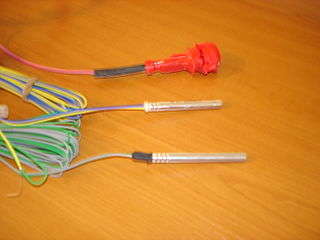
A detonator, sometimes called a blasting cap in the US, is a small sensitive device used to provoke a larger, more powerful but relatively insensitive secondary explosive of an explosive device used in commercial mining, excavation, demolition, etc.

The exploding-bridgewire detonator is a type of detonator used to initiate the detonation reaction in explosive materials, similar to a blasting cap because it is fired using an electric current. EBWs use a different physical mechanism than blasting caps, using more electricity delivered much more rapidly. Exploding with more precise timing after the electric current is applied, by the process of exploding wire method. This has led to their common use in nuclear weapons.

On January 28, 1986, the Space Shuttle Challenger broke apart 73 seconds into its flight, killing all seven crew members aboard. The spacecraft disintegrated 46,000 feet (14 km) above the Atlantic Ocean, off the coast of Cape Canaveral, Florida, at 11:39 a.m. EST. It was the first fatal accident involving an American spacecraft while in flight.
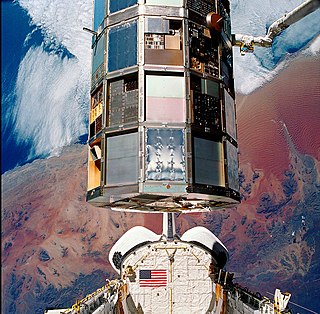
STS-32 was the 33rd mission of NASA's Space Shuttle program, and the ninth launch of Space ShuttleColumbia. Launched on January 9, 1990, it marked the first use of the Launch Complex 39A of Kennedy Space Center at since 1986; it also marked the first use of Mobile Launcher Platform-3 (MLP-3) in the Space Shuttle program. STS-32 was, at the time, the longest shuttle mission yet conducted, with a duration of nearly 11 days. Before STS-32, the only mission of the same duration had been STS-9 in 1983. On January 20, 1990, STS-32 executed the third night landing of the shuttle program. STS-32 was also the first Shuttle mission of the 1990s.

A two-stage-to-orbit (TSTO) or two-stage rocket is a launch vehicle in which two distinct stages provide propulsion consecutively in order to achieve orbital velocity. It is intermediate between a three-stage-to-orbit launcher and a hypothetical single-stage-to-orbit (SSTO) launcher.

The Space Shuttle Solid Rocket Booster (SRB) was the first solid-propellant rocket to be used for primary propulsion on a vehicle used for human spaceflight. A pair of these provided 85% of the Space Shuttle's thrust at liftoff and for the first two minutes of ascent. After burnout, they were jettisoned and parachuted into the Atlantic Ocean where they were recovered, examined, refurbished, and reused.
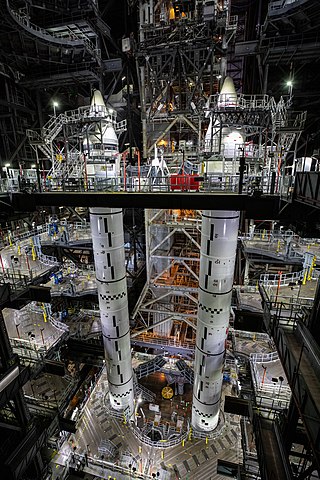
A solid rocket booster (SRB) is a large solid propellant motor used to provide thrust in spacecraft launches from initial launch through the first ascent. Many launch vehicles, including the Atlas V, SLS and Space Shuttle, have used SRBs to give launch vehicles much of the thrust required to place the vehicle into orbit. The Space Shuttle used two Space Shuttle SRBs, which were the largest solid propellant motors ever built and the first designed for recovery and reuse. The propellant for each solid rocket motor on the Space Shuttle weighed approximately 500,000 kilograms.
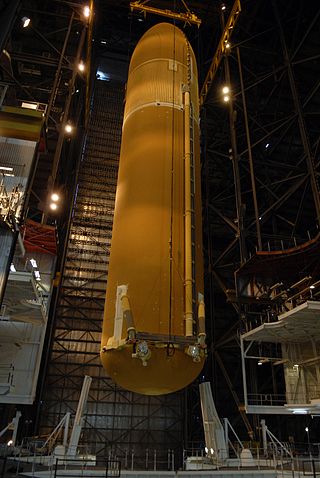
The Space Shuttle external tank (ET) was the component of the Space Shuttle launch vehicle that contained the liquid hydrogen fuel and liquid oxygen oxidizer. During lift-off and ascent it supplied the fuel and oxidizer under pressure to the three RS-25 main engines in the orbiter. The ET was jettisoned just over 10 seconds after main engine cut-off (MECO) and it re-entered the Earth's atmosphere. Unlike the Solid Rocket Boosters, external tanks were not re-used. They broke up before impact in the Indian Ocean, away from shipping lanes and were not recovered.

A mobile launcher platform (MLP), also known as mobile launch platform, is a structure used to support a large multistage space vehicle which is assembled (stacked) vertically in an integration facility and then transported by a crawler-transporter (CT) to a launch pad. This becomes the support structure for launch.

STS-51-L was the disastrous 25th mission of NASA's Space Shuttle program and the final flight of Space Shuttle Challenger.

A pyrotechnic fastener is a fastener, usually a nut or bolt, that incorporates a pyrotechnic charge that can be initiated remotely. One or more explosive charges embedded within the bolt are typically activated by an electric current, and the charge breaks the bolt into two or more pieces. The bolt is typically scored around its circumference at the point(s) where the severance should occur. Such bolts are often used in space applications to ensure separation between rocket stages, because they are lighter and much more reliable than mechanical latches.

Space Shuttle abort modes were procedures by which the nominal launch of the NASA Space Shuttle could be terminated. A pad abort occurred after ignition of the shuttle's main engines but prior to liftoff. An abort during ascent that would result in the orbiter returning to a runway or to an orbit lower than planned was called an "intact abort", while an abort in which the orbiter would be unable to reach a runway, or any abort involving the failure of more than one main engine, was called a "contingency abort". Crew bailout was still possible in some situations in which the orbiter could not land on a runway.

Ares I was the crew launch vehicle that was being developed by NASA as part of the Constellation program. The name "Ares" refers to the Greek deity Ares, who is identified with the Roman god Mars. Ares I was originally known as the "Crew Launch Vehicle" (CLV).
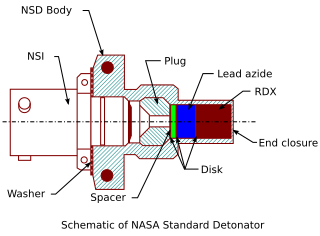
The NASA Standard Detonator (NSD) is a device used by NASA for applications where a charge must be detonated, usually in conjunction with frangible nuts as a release mechanism. NSDs have been used since the Gemini program, and were used for the Space Shuttle program, including the Solid Rocket Booster (SRB) separation from the External Tank, as well as the SRB Range Safety System. Chemring is the primary provider for the NSDs which were used on the Space Shuttle.

The booster separation motors or BSMs on the Space Shuttle were relatively small rocket motors that separated the reusable solid rocket boosters (SRB) from the orbiter after SRB burnout. Eight booster separation motors were attached to each of the shuttle's two reusable solid rocket boosters, four on the forward frustum and four on the aft skirt.

The NASA recovery ships are two ships, the MV Liberty Star and the MV Freedom Star, that were tasked with retrieving spent Solid Rocket Boosters (SRBs) following the launch of Space Shuttle missions. Although owned by NASA, the ships were operated by Space Flight Operations contractor United Space Alliance. Following the end of the Space Shuttle program, and therefore booster recovery, NASA transferred both vessels to the Department of Transportation.
The NASA Standard Initiator (NSI) is a pyrotechnic device used to set off other pyrotechnic devices. It is the central multi-purpose component of a modular system of detonating cords, pyrotechnics and various other explosive charges with many different uses.

The Delta 3000 series was an American expendable launch system which was used to conduct 38 orbital launches between 1975 and 1989. It was a member of the Delta family of rockets. Several variants existed, which were differentiated by a four digit numerical code.

During the lifetime of the Space Shuttle, Rockwell International and many other organizations studied various Space Shuttle designs. These involved different ways of increasing cargo and crew capacity, as well as investigating further reusability. A large focus of these designs were related to developing new shuttle boosters and improvements to the central tank, but also looked to expand NASA's ability to launch deep space missions and build modular space stations. Many of these concepts and studies would shape the concepts and programs of the 2000s such as the Constellation, Orbital Space Plane Program, and Artemis program.
References
- ↑ "Frangible Nut Crossover System" (PDF). NASA. Retrieved 2023-10-17.
- 1 2 3 "Space Shuttle Solid Rocket Booster - Frangible Nut Crossover System" (PDF). George C. Marshall Space Flight Center, NASA. Retrieved 18 December 2020.
 This article incorporates text from this source, which is in the public domain .
This article incorporates text from this source, which is in the public domain .